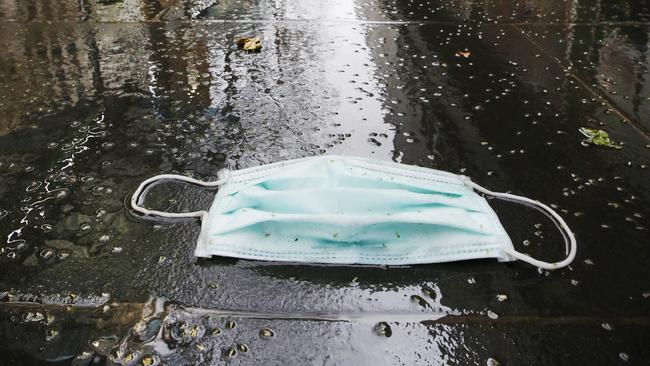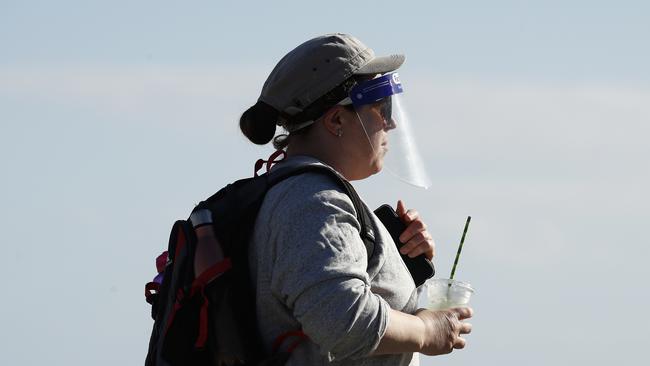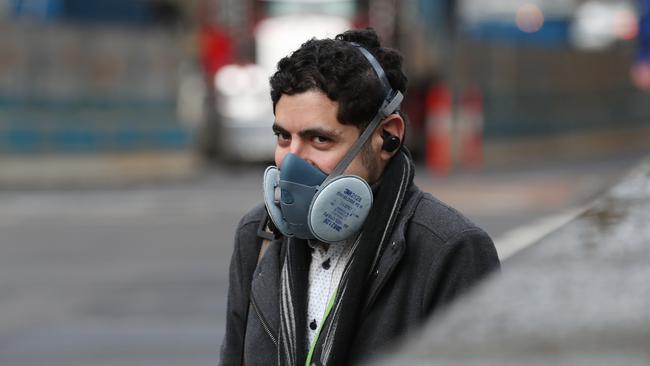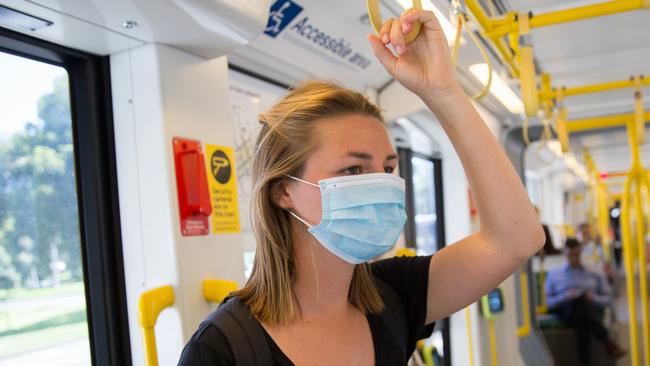Why face shields won’t protect you from COVID-19, but fabric face masks will
Victorians must wear a snug-fitting face mask in public after face shields, bandannas and scarves were deemed less effective in stopping COVID-19. Here’s the disturbing reason why you can’t solely rely on a face shield to protect you.
Face shields, bandannas and scarves are no longer considered good enough to stop the spread of coronavirus, according to Victorian health advice.
Premier Daniel Andrews said we must transition to wearing face masks that fit snug around the nose and mouth, and will allow a two week grace period before dishing out $200 fines to those not wearing them.
“Face shields don’t meet the test of covering your nose and your mouth,” the Premier said on Sunday.
“You can wear a face shield if you want to in terms of your eyes, but it would need to be accompanied by a mask and we would recommend a two-ply mask. A shield is akin to not wearing a face covering.”
Face coverings were made mandatory across Melbourne and the Mitchell shire on July 19.
Here’s what the World Health Organisation and other international research has found on face covering effectiveness.

NOT ALL FACE COVERINGS ARE EQUAL
Research published in AIP Physics of Fluid found properly-fitted cloth face masks were better at stopping water droplets from an uncovered sneeze or cough than bandannas or handkerchiefs.
The study tested the effectiveness of handkerchiefs, homemade masks and commercial cone masks.
The stitched, homemade quilting cotton mask was the most effective, followed by the commercial mask, the folded handkerchief, and, finally, the bandana.
Results from the handkerchief test found water droplets pushed forward through the protective barrier and lingered in the air.
Forward projections didn’t occur as much with either the home made or cone masks, but water particles did escape through the gap near the top of the mask.
Surprisingly, water particles from an uncovered cough were found to travel up to 12 feet (3.66 metres)— which is more double the recommended length of social distancing in Australia and the United States.

WHY FACE SHIELDS DON’T WORK
Former World Health Organisation epidemiologist Adrian Esterman said masks were better than face shields at protecting against the virus because they stopped not just droplets but also aerosolised particles.
“The general rule is that if there is little or no community transmission, there it is not needed — places like South Australia and Western Australia,” Prof Esterman said.
“But in Melbourne there is still some community transmission so it is probably still worthwhile.
Deakin University chair in epidemiology Catherine Bennett said masks protected people better than shields because they fitted closely to the face and largely stopped particles leaving or entering someone’s mouth or nose.
“If there is too much gaping at the sides, the particles or the droplets can make their way around the edge of the covering,” Prof Bennett said.
“As soon as you having gaping holes, it is not effective. It’s that marginal gain you get in terms of reduced risk of transmission.”

FACE SHIELDS INCOMPETENT IN SWISS OUTBREAK
Switzerland’s health department ruled face shields were ineffective in July after a coronavirus hotel outbreak only infected staff and guests wearing face shields for protection.
Nobody who was wearing a face mask or a combination of a face mask and face shield contracted the virus, according to Swiss authorities.
In Japan, Fugaku (the world’s fastest super computer) and research by Japanese government-backed institute Riken found 100 per cent of airborne droplets fewer than 5 micrometers in size escaped from the gap in the face shield.
At least half of the larger water droplets, 50 micrometers in size, also escaped through gaps.
Riken’s research also found non-woven fabric face masks were better at blocking COVID-19 compared to face shields.
The institute suggested face shields could potentially be used by people who don’t have a high-risk of contracting coronavirus, such as kids, only if they were in well-ventilated areas.

WORLD HEALTH ORGANISATION ADVICE
The World Health Organisation’s preference of face covering is a three-layer fabric face mask.
“If there is widespread community transmission, and especially in settings where physical distancing cannot be maintained, governments should encourage the general public to wear a fabric mask.” WHOs most recent advice on face coverings was released in August.
Previously WHO has said face shields could work combined with face masks and other measures, such as social distancing and frequent hand washing.
Here’s how you should properly fit a fabric face mask.
FACE MASKS TO BUY:
1. Ilda KN95 Face Mask 10 Pack. $30, Chemist Warehouse.
2. HPE Reusable Face Mask Adult Regular 3 Pack, $19.99, Chemist Warehouse.
3. Cotton 3 ply face mask, $10, Gorman.
Finder recommends the best face masks to wear here.
MORE NEWS:
FIVE CASES, THREE DEATHS: VICTORIAN DAILY TALLY
EVERYTHING YOU MUST KNOW ABOUT RULE CHANGES
